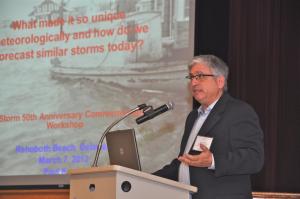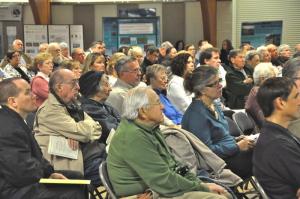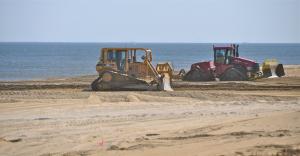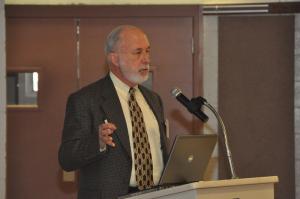Lessons learned from the Storm of '62
Fifty years ago, on March 7, 1962, the historic Rehoboth Beach Boardwalk was being ripped apart by a vicious nor'easter that pounded the coast with 20- to 30-foot waves for three days. In contrast to that day, this past March 7 was a precursor to spring with sun and blue skies luring visitors to leisurely strolls along the boards.
Fifty years ago, officials met to discuss how to survive the Storm of the Century. This year, they met to tell the public what has been learned over the past five decades during a 50th anniversary commemoration workshop.
“This storm was a defining moment for Rehoboth Beach,” Mayor Sam Cooper said, adding it not only changed the beach but also changed attitudes about storms. Cooper was 9 years old at the time of the storm.
Eight speakers addressed a large crowd in Rehoboth Convention Center during the four-hour workshop. A showing of the film, “The '62 Storm – Delaware's Shared Response,” hosted by filmmaker Michael Oates followed the workshop. Historical societies from Lewes, Rehoboth Beach and South Bethany and the Town of Bethany Beach set up displays along with several state and federal agencies.
Population growth puts many more at risk as tens of thousands more people live along the Delaware coastline than in 1962; development – especially in areas around the Inland Bays – has skyrocketed and the appeal of the Delaware beaches has grown dramatically.
In the 1960s, 50 percent of the available construction parcels along the coastline were vacant; today it's only 2 percent. Today, 50 percent of the nation's population lives along the coastline.
Fifty years ago none of the strict coastal building codes in place today existed. National flood insurance was not offered throughout Sussex County until 1976. Federal-state funded beach nourishment projects did not begin until 2005.
In the early 1970s, responsibility for the beaches was turned over from the highway department to the Delaware Department of Natural Resources and Environmental Control, said Tony Pratt, director of DNREC's Shoreline Management Branch.
A beach fund was established in 1972 for work along the shoreline. Replenishment projects took place in the 1980s and 1990s, but erosion continued. By the time the next phase of beach nourishment was put into high gear in 2005, beaches along the coast were seriously eroded. In some areas, beaches were unusable during high-tide periods. Beaches were increased from as little as 30 feet in width to several hundred feet in width. A maintenance program was also set into place.
And without beaches, the tourism industry falters. Dune and beach loss is not conducive to the area's all-important tourism industry that infuses $750 million into the county's economy and attracts more than 3 million people each year. More than 14,000 people are employed in the tourism industry.
In 2011, $40 million was awarded in contracts for the most ambitious beach replenishment work to date, with sand pumped onto beaches from Fenwick Island to Lewes. Pratt said 3 million cubic yards of sand has been dredged up onto Cape Region beaches, including 1 million cubic yards in Rehoboth Beach and Dewey and 1.6 million in Bethany Beach and South Bethany.
Another 22,000 cubic yards will be used to replenish Kitts Hummock, Bowers and South Bowers beaches, and more work is planned for Lewes and Broadkill Beach.
Pratt said the sand moved to build up the beaches and dunes in 2011-2012 far surpasses the 1.8 million cubic yards of sand pushed from the roads, homes and overwash areas onto beaches the months following the Storm of '62.
Beaches have changed over 50 years
Pratt said the current status of the beachfront is a formidable one. When asked during the workshop what would happen today if the same type of storm hit the coastline, Pratt said he could only speculate, but he did answer.
“We would not see the demolition we saw then,” he said. “There would be very little property damage on the beach side.”
Through the most recent renourishment project, beaches have been widened and impressive grass-lined dunes provide protection to homes and businesses along the coast.
Pratt said the area will continue to have a chronic problem with beach erosion and sand will continue to move as it has for thousands of years. “It's a natural process. Construction in the dune field causes problems,” he said.
Most experts agreed the real concern would be from the bay side – flooding in the Inland Bays where development has mushroomed over the past five decades. “Washover on barrier islands is a good thing because it helps to stabilize the entire coastal system,” said Kelvin Ramsey, geologist with the Delaware Geological Survey. The additional sand helps to replenish the bay coastline.
“Beach nourishment is doing its job; the flooding will come from the back side. The back bays would receive significant flooding, and there is development there we didn't have to deal with in the '62 storm. These are the areas that are most vulnerable,” Ramsey said.
Pratt said when another major storm hits, beaches would be built back as soon as possible to what they were like the day before the storm, even though it usurps the natural beach-rebuilding process. “The bottom line is that we are sand managers, and we need to be more efficient. We need to start thinking of the beach as a system that is connected along the Delmarva area,” he said.



























































